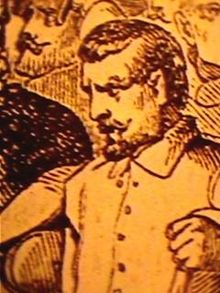Gonzalo Pizarro
Gonzalo Pizarro (* 1502 in Trujillo , Spain ; † April 10, 1548 in Cusco , Peru ) was a conquistador , a Spanish conqueror of the 16th century, and a half-brother of Francisco Pizarro .
Life
Conquista in Peru
Gonzalo Pizarro followed Francisco with his other brothers to the New World in 1530 and was involved in the conquest of the Inca Empire . When his brother Francisco traveled to the coast to the newly founded city of Ciudad de los Reyes ( Lima ) in 1535 , Gonzalo and his brother Juan stayed as governors in the Inca capital Cusco . Both treated the newly installed Inca ruler Manco very badly; Gonzalo even wanted his sister-wife Cura Ocllo. As a result, he was partly responsible for the fact that Manco stood up against the Spaniards and organized an uprising. Gonzalo survived the siege of Cusco (1536/1537) together with his brother Hernando .
Francisco Pizarro's former partner, Diego de Almagro , who had become a rival, captured Gonzalo and Hernando in Cusco, but Gonzalo escaped soon after. Together with Hernando he defeated Almagro in the Battle of Las Salinas . He then moved south, to what is now Bolivia, and there to crush Manco's rebellion. He was actively supported by Manco's half-brother Paullu . From April to July 1539 he undertook a campaign against Manco, who was in his fortress Vilcabamba . But Manco narrowly escaped.
Expedition to the Amazon
To protect his interests, his brother Francisco appointed him governor in Quito . From there he went on an expedition to the Amazon region in 1540 with Francisco de Orellana in search of the legendary "cinnamon land". When he returned to Quito in 1542, ragged and half starved, he had to learn that his brother Francisco, the governor of the conquered territories called " New Castile ", had been murdered.
Rebellion against the viceroy
In the same year the viceroyalty of Peru was founded by royal decree with Blasco Núñez Vela as the first viceroy. When he arrived in Peru and wanted to enforce the Leyes Nuevas ("New Laws") to protect the Indians, the Spanish settlers rebelled and chose Gonzalo Pizarro to be their leader. Pizarro defeated Núñez Vela in the Battle of Añaquito (1546) and extended his sphere of influence to Panama . As a result, the rebellion collapsed and ended in 1548 with the Battle of Jaquijahuana . Pizarro was sentenced to death for high treason and tyranny.
Gonzalo Pizarro was beheaded in Cusco on April 10, 1548. His last words (to the executioner ) are said to have been "Do your job well, Juan!"
progeny
Gonzalo had a son, Francisquito, and a daughter, Inés, with an Inca princess. After Gonzalo's rebellion was put down, the children were taken to Spain on royal orders. Inés married her cousin Francisco (son of her uncle Francisco Pizarro, the conqueror of Peru). But Francisco died in 1557. Two years later Inés married the Conquistador Francisco de Hinojosa.
reception
"Gonzalo Pizarro era valiente, sabia poco, tenia muy buen rostro y buena barba, hombre apretado y no largo, y muy buen hombre de á caballo."
"Gonzalo Pizarro was brave, knew little, had a very good face and a good beard, a stocky, not tall man and a very good rider."
literature
- John Hemming: The Conquest of the Incas . Mariner Books, Boston 2003, ISBN 0-15-602826-3 .
- Howard Clewes: The other Pizarro , Munich 1979
Individual evidence
- ↑ Gonzalo Pizarro on britannica.com
- ^ John Hemming: The Conquest of the Incas . 2003, ISBN 0-15-602826-3 , pp. 276-277 .
- ↑ Pedro Pizarro : Relación del descubrimiento y conquista de los reinos del Perú. 1571, p. 311 , accessed June 27, 2016 (Spanish, Google Books).
| personal data | |
|---|---|
| SURNAME | Pizarro, Gonzalo |
| BRIEF DESCRIPTION | Spanish conquistador |
| DATE OF BIRTH | 1502 |
| PLACE OF BIRTH | Trujillo , Spain |
| DATE OF DEATH | April 10, 1548 |
| Place of death | Cusco , Peru |
